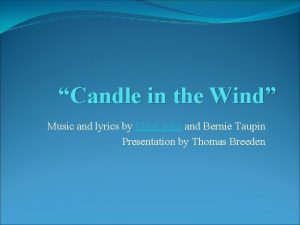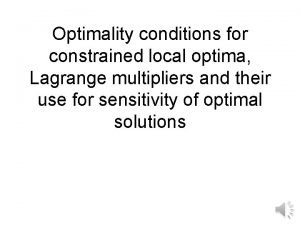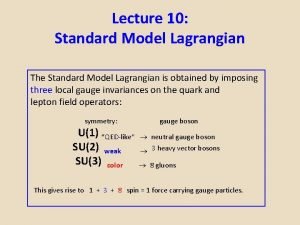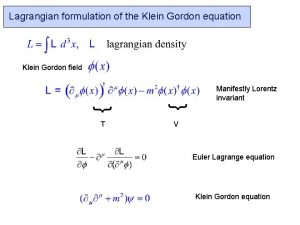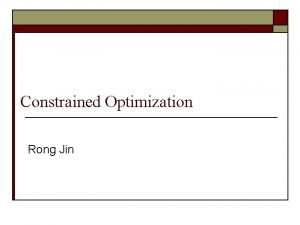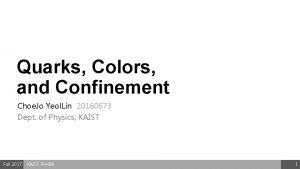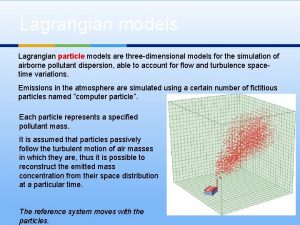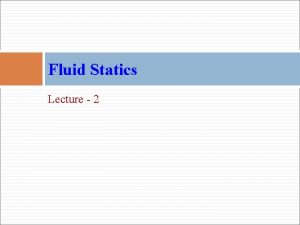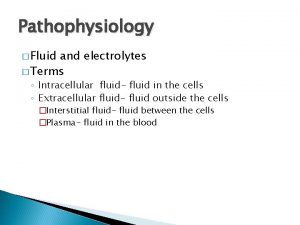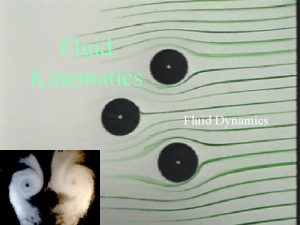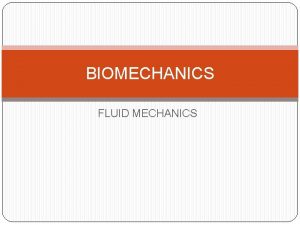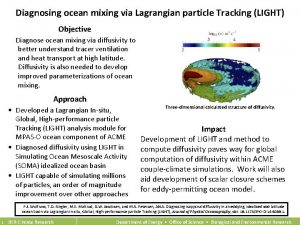Lagrangian Mixing John Elton Fluid mixing is a

















- Slides: 17

Lagrangian Mixing John Elton

• Fluid mixing is a problem of interest both from a theoretical standpoint as well for its applications in engineering and industry – Heat transport – Chemical mixing in pharmaceuticals – Geophysical studies of wind-driven ocean streamlines • There is no universal theory of mixing because each application must be treated differently • Roughly three approaches to studying mixing: geometry, kinetics, and structures – How can complex patterns be characterized? – What is the time scale of the process? • Studies on dispersion address the problem of the growth rate of tracer blobs placed in a prescribed field – Reynolds, colored bands

• Others study the behavior of large-scale vortical structures sustained by shear flows • The importance of coherent vortices in mixing and turbulence remains an open question • Many studies show the coherent structures to play a crucial role in turbulent transport, but an extraction of such structures from experimental or numerical data has proven challenging – Lack of an accepted definition for coherence in the lab frame

• At high Re number ( > 10^3) flows become fully turbulent • Turbulence characterized by an unpredictable and seemingly random behavior and a wide range of length scales • Mixes transported quantities more efficiently than laminar flows where only molecular diffusion is involved – Turbulent Diffusion • At lower Re numbers, however, mixing can still occur if the fluid pathlines are chaotic – “Lagrangian Chaos” – Can occur in regular, smooth flows

• Eulerian (fixed lab) vs. Lagrangian (particle) viewpoints – Big idea of Lagrangian chaos is the observation that velocity fields which are smooth, regular, and boring when viewed in the traditional Eulerian frame can produce fluid pathlines which uniformly fill out a volume in an ergodic way – When molecular diffusivity is small, mixing at low Re becomes difficult, and the flow field must efficiently disperse the material – These chaotic fluid pathlines disperse material efficiently • Lagrangian chaos suffers the problem of not always achieving good global mixing – Stretching and folding of material surfaces near a vortex can produce efficient mixing near the vortex, but there is poor communication with the rest of the fluid, and mixing only occurs locally

• How to quantify good mixing? • Several, somewhat application specific – Compare r. m. s. fluctuations of fluid concentration with the mean level. Rate of decrease of the fluctuations specifies the time scale at which mixing occurs – Study the rate of increase of the interfacial area of a material surface (such as a tracer blob). This is governed by the Lyapunov exponent. – Lyapunov exponent is a local measure. In Eulerian turbulence the wide range of length and time scales makes an average of the Lyapunov exponent less meaningful. However, chaotic pathlines produce good mixing with nonzero Lyapunov exponents

• Lagrangian chaos leads to the possibility of efficient mixing at low Re numbers and to a better understanding of turbulent mixing when diffusivity is small • This motivates the study of the paths of tracer particles in a fixed velocity field. Most naturally, start with an equilibrium velocity field. • We wish to study the way in which invariant surfaces within the fluid provide a boundary for all tracer particles and define regions within the fluid where the most efficient mixing occurs. • Applying this analysis to plane Couette flow should lead to a novel description and understanding of the ways in which mixing may occur in turbulent shear flows • Initial progress has been made with the discovery of stagnation points within the fluid (where no motion occurs) and heteroclinic connections between them










 Sacrifice elton john
Sacrifice elton john Elton john marilyn monroe lyrics
Elton john marilyn monroe lyrics Fluid sf
Fluid sf P1-p2
P1-p2 Fluid statics deals with
Fluid statics deals with Transcellular fluid compartment
Transcellular fluid compartment Interstitial fluid vs extracellular fluid
Interstitial fluid vs extracellular fluid Hypoosmotic
Hypoosmotic Timeline in fluid mechanics
Timeline in fluid mechanics Extracellular fluid and interstitial fluid
Extracellular fluid and interstitial fluid Chylous ascites causes
Chylous ascites causes Lagrange multipliers
Lagrange multipliers Lagrangian standard model
Lagrangian standard model Klein-gordon lagrangian
Klein-gordon lagrangian Electroweak lagrangian
Electroweak lagrangian Lagrangian optimization
Lagrangian optimization Eulerian vs lagrangian
Eulerian vs lagrangian Lagrangian
Lagrangian

